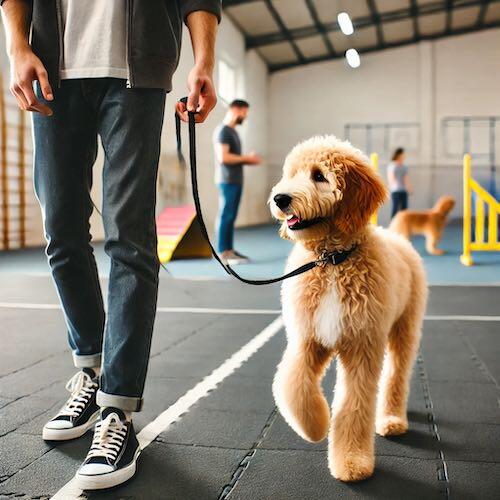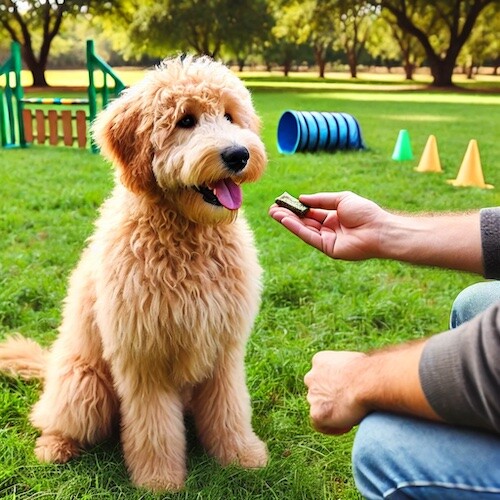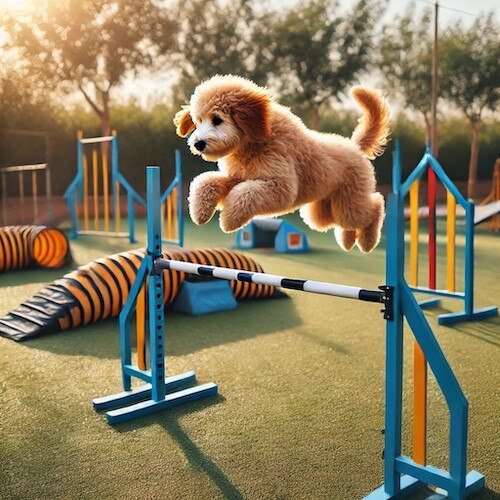
How to Train a Goldendoodle: The Ultimate Guide
Introduction
Goldendoodles, a crossbreed between Golden Retrievers and Poodles, have captured the hearts of many dog enthusiasts due to their exceptional temperament, intelligence, and hypoallergenic coats. These traits, combined with their versatility in size—ranging from standard to miniature and toy—make them ideal companions for a variety of households.
Their adaptability and affectionate nature also lend themselves well to roles as service and therapy dogs. This comprehensive guide will delve into the essential aspects of training and caring for Goldendoodles, ensuring they thrive in their environments.
Overview of Goldendoodle Dogs
Goldendoodles, created by breeding Golden Retrievers with Poodles, exhibit a blend of the best characteristics from both breeds. They are celebrated for their friendly disposition, intelligence, and low-shedding coats, making them suitable for families, individuals with allergies, and those looking for trainable, loyal pets.
Read More: Top 20 Most Expensive Dog Breeds in the World
The size of a Goldendoodle can vary significantly based on whether the Poodle parent is standard, miniature, or toy. Regardless of size, Goldendoodles are known for their sociable and affectionate nature, combined with the Poodle’s quick learning abilities and hypoallergenic fur.
Typically, Goldendoodles are medium to large-sized dogs, though their dimensions can vary. They often boast a curly or wavy coat that is easy on allergies, reflecting the Poodle’s influence. Physically, they are robust and athletic, mirroring their energetic temperament. Coat colors can range from cream, gold, and red to black and chocolate, requiring regular grooming to maintain their health and prevent matting.
Mentally, Goldendoodles are highly intelligent and eager to please, making them quick learners. This intelligence, however, necessitates consistent mental stimulation to avoid boredom-related behavioral issues. Their combination of traits makes them excellent family pets, therapy dogs, and service animals, enhancing their appeal to a wide audience.
Importance of Training
Training a Goldendoodle is crucial for several reasons. Firstly, their high intelligence and energy levels mean they require both mental and physical stimulation to avoid boredom and destructive behaviors like excessive barking, chewing, or digging. Proper training provides an outlet for their energy, ensuring they remain engaged and well-behaved.
Training also strengthens the bond between the dog and the owner. Through structured training, Goldendoodles learn to understand and respond to commands, fostering better communication and a more harmonious relationship. Well-trained Goldendoodles tend to be more confident and secure, reducing their propensity for anxiety and aggression.
Moreover, training ensures the safety of both the dog and those around them. A well-trained Goldendoodle is less likely to engage in dangerous behaviors, such as running into traffic or jumping on strangers. Effective training not only manages their natural exuberance but also creates a loving and secure environment for them to thrive.

Understanding Goldendoodle Dogs
Breed Characteristics
Goldendoodles are a unique blend of Golden Retrievers and Poodles, combining the best traits of both breeds. Typically medium to large-sized, their size can vary depending on the Poodle parent. They feature a curly or wavy coat that is low-shedding and hypoallergenic, making them suitable for people with allergies. Their sturdy, athletic build reflects their energetic and playful nature, and their coat can come in various colors, including cream, gold, red, black, and chocolate. Regular grooming is essential to maintain their coat’s health and prevent matting.
Mentally, Goldendoodles are known for their intelligence and eagerness to please. They inherit the problem-solving abilities of Poodles and the sociability of Golden Retrievers, making them quick learners. However, their intelligence also means they need consistent mental stimulation to prevent boredom and associated behavioral issues.
Common Behavior Traits
Goldendoodles are renowned for their friendly and outgoing nature. They thrive on human interaction and often get along well with children and other pets, making them excellent family pets. Their gentle disposition and high energy levels require regular exercise to keep them happy and healthy. Daily walks, playtime, and activities that engage both their mind and body are essential to meet their exercise needs.
Their curiosity and love of exploration can sometimes lead to mischievous behavior if not properly managed. Early training and socialization are crucial to ensure they develop into well-behaved and balanced dogs. Goldendoodles are generally social animals, and their behavior reflects their need for companionship and interaction.
Preparing for Training
Setting Up the Environment
Creating an optimal training environment is crucial for the success of your Goldendoodle’s training. Choose a quiet, distraction-free area where your dog can focus on learning. Initially, indoor training sessions are ideal to minimize distractions and help your Goldendoodle concentrate. As your dog becomes more proficient, gradually introduce outdoor sessions to expose them to different environments.
Search: Best Selling Goldendoodle Products Online
Ensure that the training area is safe and secure. Remove any potential hazards or items that could distract your Goldendoodle. Having a consistent training space helps signal to your dog that it’s time to focus and learn. Additionally, maintaining a positive atmosphere in the training area encourages your Goldendoodle to look forward to these sessions.
Essential Training Tools
Equipping yourself with the right tools can significantly enhance the effectiveness of your Goldendoodle’s training. Here are some essential tools to consider:
- Leash and Collar: A sturdy leash and a comfortable, well-fitting collar are fundamental for leash training and general control.
- Training Treats: High-value treats that your Goldendoodle finds irresistible can be used as rewards for good behavior. Choose small, healthy treats to avoid overfeeding.
- Clicker: A clicker is a valuable tool for positive reinforcement training. The sound of the clicker marks the desired behavior, making it easier for your dog to understand what you want.
- Toys: Interactive toys can be used as rewards and to keep your Goldendoodle mentally stimulated.
- Crate: A crate provides a safe space for your Goldendoodle and is essential for crate training and housebreaking.
Having these tools on hand will make your training sessions more productive and enjoyable for both you and your Goldendoodle.
Basic Training Principles
Positive Reinforcement
Positive reinforcement is one of the most effective training methods for Goldendoodles. This approach involves rewarding your dog for displaying desired behaviors, which encourages them to repeat those behaviors in the future. Rewards can be in the form of treats, praise, or playtime.
To implement positive reinforcement effectively, it’s important to reward your Goldendoodle immediately after they perform the desired behavior. This helps them make the connection between the behavior and the reward. For instance, if you are teaching your Goldendoodle to sit, give them a treat and praise as soon as they sit down. Consistency is key; ensure you reward the behavior every time, especially in the initial stages of training.
Positive reinforcement not only makes training enjoyable for your Goldendoodle but also strengthens the bond between you and your dog. It fosters a positive learning environment where your Goldendoodle feels motivated and confident to learn new commands and behaviors.
Consistency and Patience
Training a Goldendoodle requires consistency and patience. Dogs thrive on routine and predictability, so it’s essential to be consistent in your commands, rewards, and expectations. Use the same words and signals for each command to avoid confusing your dog. For example, if you use the word “sit,” always use that word and not variations like “sit down” or “sit here.”
Patience is equally important, as Goldendoodles can sometimes be stubborn or easily distracted. Training sessions should be short and frequent, ideally 10-15 minutes, to keep your Goldendoodle’s attention and prevent them from becoming bored. Celebrate small victories and progress, and avoid punishment or negative reinforcement, as this can lead to fear and anxiety.
Remember, every dog learns at their own pace. Stay patient and positive, and your Goldendoodle will eventually grasp the commands and behaviors you are teaching.
Early Training (Puppy Stage)
Socialization
Socialization is one of the most critical aspects of training for a Goldendoodle puppy. The period between 3 to 14 weeks is a crucial window for socialization, where your puppy is most receptive to new experiences. Exposing your Goldendoodle to a variety of people, animals, environments, and sounds during this period helps them develop into well-adjusted and confident adults.
Take your puppy to different places such as parks, pet stores, and neighborhoods to expose them to various sights and sounds. Arrange playdates with other vaccinated puppies and friendly dogs to teach them appropriate social behavior. Introduce your Goldendoodle to different types of people, including children, adults, and seniors, to ensure they are comfortable around various individuals.
Positive experiences during socialization help prevent fear and aggression in the future. Reward your puppy with treats and praise for calm and confident behavior in new situations. Avoid overwhelming your puppy with too much too soon; gradually increase the complexity and intensity of new experiences.
House Training
House training, or potty training, is essential for a Goldendoodle puppy. Start by establishing a regular feeding schedule, as this helps regulate their bathroom habits. Take your puppy outside frequently, especially after meals, playtime, and naps, as these are the times they are most likely to need to go.
Choose a specific spot outside where you want your Goldendoodle to do their business. Consistently taking them to the same spot helps them associate the area with potty time. Use a command like “go potty” to signal to your puppy what you expect them to do.
When your Goldendoodle successfully goes potty outside, reward them immediately with praise and treats. Positive reinforcement helps reinforce the desired behavior. Accidents will happen, especially in the early stages, so be patient and avoid punishment. If you catch your puppy in the act of having an accident indoors, gently interrupt them and take them outside to finish.
Consistency and patience are key to successful house training. With time and positive reinforcement, your Goldendoodle will learn to associate going outside with potty time.

Basic Commands
Teaching basic commands is essential for establishing good behavior and communication with your Goldendoodle. Start with simple commands like “sit,” “stay,” and “come.” These commands form the foundation for more advanced training and help keep your Goldendoodle safe in various situations.
- Sit: Hold a treat close to your Goldendoodle’s nose and slowly move it upwards, causing them to sit down naturally. As soon as they sit, say “sit” and give them the treat. Repeat this several times a day until your Goldendoodle reliably sits on command.
- Stay: Ask your Goldendoodle to sit, then hold your hand out in front of you and say “stay.” Take a step back, then return and reward your dog if they stay in place. Gradually increase the distance and duration of the stay command as your Goldendoodle gets better at it.
- Come: Use a long leash and let your Goldendoodle wander a short distance. Say “come” in an enthusiastic tone while gently pulling the leash towards you. Reward your dog with treats and praise when they come to you. Practice this command in various locations to ensure your Goldendoodle responds reliably.
Keep training sessions short and fun, using positive reinforcement to encourage your Goldendoodle to learn and obey commands. Consistent practice and patience will help your Goldendoodle master these basic commands.
Advanced Training
Leash Training
Leash training is essential for safe and enjoyable walks with your Goldendoodle. Start by getting your dog accustomed to wearing a collar and leash indoors. Let them wear it for short periods while offering treats and praise to create a positive association.
Once your Goldendoodle is comfortable with the leash, begin practicing indoors by walking around your home. Encourage your dog to walk beside you by holding a treat at your side and rewarding them for staying close. Use a command like “let’s go” to signal the start of the walk.
When your Goldendoodle consistently walks nicely on the leash indoors, gradually move to outdoor walks. If your dog pulls on the leash, stop walking and stand still until they return to your side. Reward them for walking beside you without pulling. Consistency is key; avoid allowing your Goldendoodle to pull you in any direction they want to go.
Leash training can be challenging, especially for an energetic breed like Goldendoodles. Patience and positive reinforcement will help you achieve a well-behaved walking companion.
Obedience Training
Obedience training is about teaching your Goldendoodle to respond reliably to commands in various situations. Building on the basic commands, you can introduce more complex commands and tasks.
- Heel: Teach your Goldendoodle to walk closely beside you without pulling. Start with short distances and gradually increase the duration. Use treats and praise to reward them for staying in the correct position.
- Down: Ask your Goldendoodle to sit, then hold a treat close to their nose and slowly move it to the ground. As your dog follows the treat, say “down” and reward them once they are lying down.
- Leave It: Place a treat on the ground and cover it with your hand. When your Goldendoodle shows interest, say “leave it” and wait until they lose interest. Reward them with a different treat when they ignore the covered treat. Gradually increase the difficulty by using more tempting items and practicing in different environments.
Consistent practice and positive reinforcement are crucial for successful obedience training. Regularly reinforce the commands to ensure your Goldendoodle responds reliably in various situations.
Crate Training
Crate training provides your Goldendoodle with a safe and comfortable space and aids in house training and preventing destructive behavior. Choose a crate that is large enough for your Goldendoodle to stand, turn around, and lie down comfortably.
Introduce the crate gradually by placing treats and toys inside and allowing your Goldendoodle to explore at their own pace. Use a command like “crate” to signal your dog to go inside. Initially, leave the door open and let your dog enter and exit freely.
Once your Goldendoodle is comfortable, start closing the door for short periods while you are at home. Gradually increase the time your dog spends in the crate, always rewarding them with treats and praise for calm behavior.
Use the crate for short periods when you are away from home, gradually increasing the duration as your Goldendoodle becomes more comfortable. Avoid using the crate as a punishment, as this can create negative associations.
Crate training helps with house training, prevents destructive behavior, and provides a safe space for your Goldendoodle to relax. With patience and positive reinforcement, your Goldendoodle will learn to see the crate as their den.
Behavioral Training
Addressing Common Issues
Goldendoodles, like all dogs, can develop behavioral issues that need to be addressed through training and management. Common issues include chewing, barking, and digging. Understanding the underlying causes of these behaviors is essential for effective training.
- Chewing: Goldendoodles have a natural urge to chew, especially during teething. Provide appropriate chew toys and keep valuable items out of reach. If your Goldendoodle chews on inappropriate objects, redirect them to a chew toy and reward them for using it.
- Barking: Excessive barking can be a sign of boredom, anxiety, or alertness. Identify the cause and address it accordingly. Provide mental and physical stimulation, and use commands like “quiet” to teach your Goldendoodle to stop barking on command. Reward them for being quiet and calm.
- Digging: Digging is a natural behavior for many dogs. Provide a designated digging area in your yard and encourage your Goldendoodle to dig there. Redirect them to the designated area if they dig elsewhere and reward them for using the correct spot.
Consistency, patience, and positive reinforcement are key to addressing these common behavioral issues. Understanding your Goldendoodle’s needs and providing appropriate outlets for their natural behaviors will help prevent and manage these issues.
Separation Anxiety
Separation anxiety is common in Goldendoodles, as they are highly social and bond closely with their owners. Signs of separation anxiety include excessive barking, destructive behavior, and house soiling when left alone.
To help your Goldendoodle cope with separation anxiety, start by gradually getting them used to being alone. Begin with short periods of separation and gradually increase the duration. Create positive associations with your departure by giving your dog a special treat or toy that they only get when you leave.
Establish a consistent routine and avoid making a big fuss when leaving or returning home. Practice leaving and returning calmly to reduce anxiety.
Provide mental and physical stimulation to keep your Goldendoodle occupied while you are away. Puzzle toys, treat-dispensing toys, and interactive games can help keep them engaged.
In severe cases of separation anxiety, consult with a veterinarian or a professional dog trainer for additional strategies and support.
Aggression Management
Aggression in Goldendoodles can be a result of fear, territorial behavior, or lack of socialization. It’s essential to address aggression early to prevent it from escalating.
- Socialization: Expose your Goldendoodle to various people, animals, and environments to reduce fear and build confidence. Positive experiences during socialization help prevent aggressive behavior.
- Training: Teach your Goldendoodle commands like “sit,” “stay,” and “leave it” to manage their behavior in potentially stressful situations. Use positive reinforcement to reward calm and non-aggressive behavior.
- Professional Help: If your Goldendoodle shows signs of aggression, consult with a professional dog trainer or behaviorist. They can help identify the underlying causes and develop a tailored training plan to address the issue.
Avoid using punishment or harsh methods, as these can increase fear and aggression. Patience, consistency, and positive reinforcement are crucial for managing and reducing aggressive behavior.
Physical and Mental Exercise
Importance of Exercise
Regular exercise is vital for the health and well-being of a Goldendoodle. Their high energy levels and athletic build require ample physical activity to keep them fit and prevent boredom.
Daily walks, play sessions, and activities like fetch and tug-of-war help burn off excess energy and keep your Goldendoodle physically healthy. Aim for at least an hour of exercise each day, broken into multiple sessions if possible.
Exercise also provides mental stimulation and helps prevent behavioral issues caused by boredom. Interactive games, agility training, and obedience exercises engage your Goldendoodle’s mind and keep them sharp.

Mental Stimulation Activities
Goldendoodles are intelligent dogs that thrive on mental challenges. Providing mental stimulation is just as important as physical exercise.
- Puzzle Toys: Toys that require your Goldendoodle to solve a problem to get a treat keep them engaged and mentally stimulated.
- Training Sessions: Regular training sessions challenge your Goldendoodle’s mind and reinforce obedience and good behavior.
- Interactive Games: Games like hide-and-seek, where you hide treats or toys for your Goldendoodle to find, provide mental stimulation and fun.
- Agility Training: Set up a mini agility course in your yard with obstacles like jumps, tunnels, and weave poles. Agility training provides both physical and mental exercise and strengthens the bond between you and your dog.
Providing a combination of physical and mental exercise helps keep your Goldendoodle happy, healthy, and well-behaved.
Training for Specific Activities
Agility Training
Agility training is a fun and challenging activity that utilizes your Goldendoodle’s athleticism and intelligence. It involves navigating a course of obstacles such as jumps, tunnels, and weave poles.
Start by introducing your Goldendoodle to each obstacle individually. Use treats and praise to encourage them to go through or over the obstacles. Gradually combine multiple obstacles to create a course.
Agility training improves your Goldendoodle’s physical fitness, coordination, and focus. It also provides a great way to bond with your dog and keep them mentally stimulated.
Therapy Dog Training
Goldendoodles have a natural affinity for people and can make excellent therapy dogs. Therapy dogs provide comfort and support to individuals in hospitals, nursing homes, schools, and other settings.
Training a Goldendoodle to be a therapy dog involves socialization, obedience training, and exposure to various environments and situations. They need to be calm, friendly, and well-behaved around people of all ages and abilities.
Enroll your Goldendoodle in a therapy dog training program to prepare them for certification. These programs provide the necessary training and support to ensure your dog meets the requirements for therapy work.
Service Dog Training
Goldendoodles’ intelligence and trainability make them suitable candidates for service dog training. Service dogs assist individuals with disabilities by performing tasks that help them live independently.
Training a Goldendoodle to be a service dog requires a high level of obedience and task-specific training. Common tasks for service dogs include retrieving items, opening doors, and providing balance support.
Enroll your Goldendoodle in a professional service dog training program to ensure they receive the specialized training needed for this role. These programs provide the expertise and support to prepare your dog for service work.
Health and Nutrition
Diet and Feeding Tips
A balanced diet is essential for your Goldendoodle’s health and well-being. Choose high-quality commercial dog food that meets your Goldendoodle’s nutritional needs, or consult your veterinarian for advice on homemade diets.
Feed your Goldendoodle according to their age, weight, and activity level. Divide their daily food intake into two or three meals to prevent overeating and reduce the risk of bloat.
Ensure your Goldendoodle has access to fresh water at all times. Monitor their weight and adjust their diet as needed to maintain a healthy weight.
Avoid feeding your Goldendoodle table scraps or foods that are toxic to dogs, such as chocolate, grapes, and onions. Stick to a consistent feeding schedule and avoid abrupt changes in their diet.
Regular Health Check-Ups
Regular veterinary check-ups are crucial for maintaining your Goldendoodle’s health. Schedule annual or bi-annual visits to monitor their overall health, update vaccinations, and address any potential issues.
Keep up with routine preventive care, including vaccinations, parasite control, and dental care. Regular grooming, such as brushing their coat, cleaning their ears, and trimming their nails, also contributes to their overall health and well-being.
Be aware of common health issues in Goldendoodles, such as hip dysplasia, ear infections, and allergies. Early detection and treatment can help manage these conditions and improve your Goldendoodle’s quality of life.
Maintaining Training Consistency
Long-Term Training Strategies
Training is a lifelong process that requires ongoing effort and consistency. Continue reinforcing commands and behaviors throughout your Goldendoodle’s life to ensure they remain well-behaved and responsive.
Incorporate training into your daily routine to keep your Goldendoodle engaged and mentally stimulated. Use positive reinforcement and reward good behavior to maintain motivation.
Set aside time for regular training sessions and practice commands in various environments to reinforce reliability. Consistency and patience are key to maintaining training success.
Involving Family Members
Involving all family members in training ensures consistency and reinforces good behavior. Everyone in the household should use the same commands and training techniques to avoid confusion.
Encourage family members to participate in training sessions and provide opportunities for them to bond with your Goldendoodle. This helps your dog understand that they must listen to and respect everyone in the household.
Consistency in rules and expectations across all family members helps prevent behavioral issues and ensures your Goldendoodle remains well-behaved.
Conclusion
Recap of Key Points
Training a Goldendoodle dog requires patience, consistency, and positive reinforcement. Understanding the breed’s characteristics and behavior traits is essential for effective training. Early socialization, house training, and teaching basic commands form the foundation for a well-behaved Goldendoodle.
Advanced training, addressing behavioral issues, and providing physical and mental exercise help keep your Goldendoodle engaged and well-rounded. Training for specific activities, maintaining a balanced diet, and ensuring regular health check-ups contribute to your Goldendoodle’s overall health and happiness.
By following these guidelines, you can ensure your Goldendoodle grows into a well-behaved, healthy, and happy companion.
